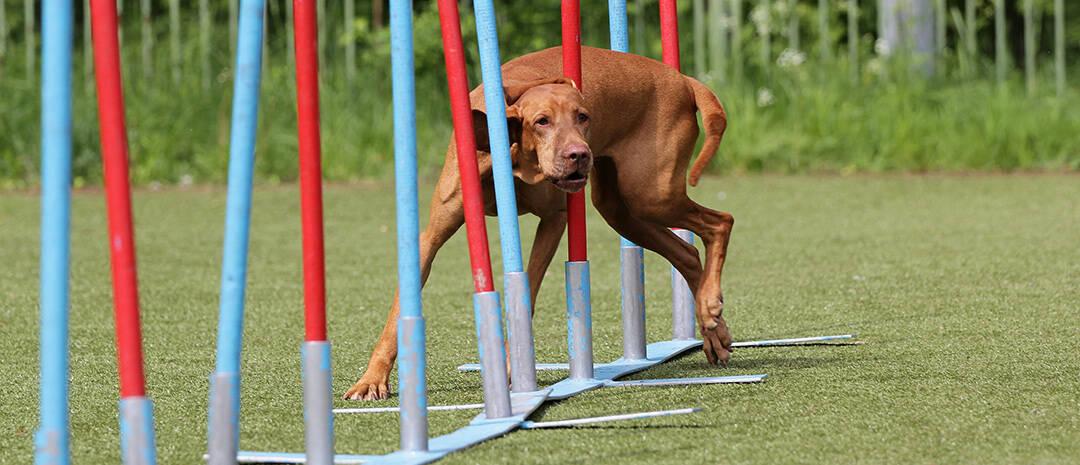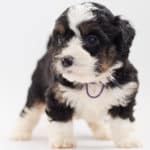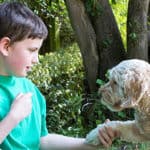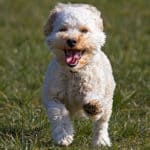The Hungarian Vizsla’s elegant appearance and gorgeous golden-rust colored coat might lead you to believe that this is a dog of royalty, and indeed you would be correct! In Hungary’s early history, owning a Vizsla was a symbol of aristocracy and the pure bloodlines were carefully preserved.
While times have changed since then, the Vizsla is treasured nonetheless by both hunters and families alike. Full of energy, a Vizsla is content to hunt for hours on end during the day and snuggle up happily with his family by night. This versatile breed is intelligent, affectionate, playful, gentle, and incredibly agile.
Are Vizslas good at agility? Vizslas are extremely good at agility thanks to their background as hunters. Their high stamina, train-ability, and graceful movements make them perfectly suited to agility. AKC Quintuple champion Chartay, whose title included Master Agility Champion, was a Vizsla.
Becoming familiar with the basics of the sport and discovering how easy it actually is to get started on your own can be all the motivation you need to begin a fantastic partnership in agility with your Vizsla.
This What Is Agility Training?
Dog agility training is a fantastic way to exercise your dog’s body and mind. It’s a sport based program dogs can train and learn to perform. While all dog’s benefit from this kind of dual workout, Vizslas, in particular, thrive when given lots of physical activity and the opportunity to stretch themselves mentally. Agility training is an excellent way to take care of your Vizslas physical exercise of course, but it’s also helping her mental stimulation. We go into the importance of mental stimulation often at Trending Breeds. It’s something that can be overlooked.
So, what exactly is involved?
About the sport
Agility is a physically demanding sport in which the handler uses cues and body language to direct the dog through a predetermined course usually consisting of 14 – 20 obstacles. The goal is to complete the course without any faults as fast as possible.
This fast-growing sport originated in England in 1970 as a demonstration in obedience and deftness. After being presented as entertainment for the spectators to enjoy between events at the Crufts Dog Show in 1978, the sport rapidly grew in popularity. Onlookers are often amazed at the speed, nimbleness, and accuracy of the competing dogs.
Obstacles
An agility course is designed to mimic the various obstructions often encountered by hunting dogs. Picture for a moment a dog hot on the trail of a fleeing rabbit. The terrified rabbit is leading the dog on a wild chase dashing through hedges and vegetation, leaping over fallen logs, darting across downed trees, and weaving among close-growing saplings in a desperate attempt to elude his pursuer.
Now you can see how the idea for agility obstacles came about. In competitions, dogs are required to navigate across dog walks and teeter-totters, dash through tunnels, briefly stop on pause tables, zigzag through weave poles, leap through hoops, soar over jumps, and negotiate their way over A-frames.
Judging
Three of the obstacles, the dog walk, teeter-totter, and the A-frame are marked with yellow areas called contact zones. Competing dogs must touch each of these zones with at least one foot to avoid earning a fault. The zones are there to not only demonstrate correct training but also to ensure the safety of competitors.
Agility competitions, referred to as trials, are judged according to accuracy and speed. Although each host organization tends to have slightly different rules concerning faults (mistakes), the basic guidelines are similar. Faults can be given for the following:
- Exceeding the allotted course completion time.
- Missing a contact zone.
- Dislodging a bar over a jump.
- Entering an obstacle from the wrong direction.
- Not adhering to the correct sequence of obstacles.
- Missing an obstacle entirely.
- Handler touching either the dog or obstacle.
When determining the winning team, three aspects of the run are taken into account: whether or not the team had a clear run, how many total faults were issued per team, and the team’s speed in completing the course.
Spotlight: Chartay
In the summer of 2000, a Vizsla named Chartay became the first dog ever to win five different American Kennel Club (AKC) championship titles. Her victories included Triple Champion (she held the titles of Conformation Champion, Field Champion, and Obedience Trial Champion), Amateur Field Champion, and Master Agility Champion. She also held the title of Utility Dog Excellent 5, Master Hunter, Master Gold Agility, Master Silver Jumpers With Weaves, and Versatile Companion.
Chartay’s official name was FCH AFC MACH OTCH CH Legacy’s DeChartay UDX5, MH, MXG, MJS, VC, HOF. That is a mouthful, but incredibly impressive. In 2007, she was honored in The Vizsla Club of America’s Hall of Fame and her portrait is now on display in the lobby of AKC headquarters.
When And How To Start Agility Training
Most organizations require that dogs be 18 months old before being eligible to compete and for good reason. Puppies have soft bones and open growth plates which can be easily and permanently damaged by repetitive, jarring actions like jumping.
The good news is that even if your Vizsla is still a pup, you can begin what is called pre-agility training right away. Basic obedience training can be started as early as 8 weeks old. This is fundamental in agility, so don’t be lazy with this one.
Once the basic commands have been thoroughly mastered, you can start training your Vizsla in basic flatwork. Introduce him to short tunnels, teach him how to “target” (touch a part of the body to a designated object on command), to navigate poles placed on the ground, to hop through a tire placed upright on the ground, and even to walk across planks or slightly raised teeter-totters.
Dogs that have passed their first birthday can begin to practice more difficult maneuvers like weave poles and jumps. Gradually increase the difficulty of obstacles and the height of jumps as your dog’s skill level increases.
The keys to properly training for agility are:
- Keep sessions upbeat, brief, and fun.
- Reward correct responses.
- Be consistent with commands and body language.
- Always be patient and end on a good note.
- Practice!
If you don’t feel confident enough to begin training on your own, there are many classes offered through various organizations to teach you and your dog the correct techniques and get you started off on the right foot. Take the plunge and sign up. Our friends at Active Dog Sports talk more about getting started with agility training and the cost, in this article.
Take Agility To the Next Level
If you feel that you are ready to begin competing, consider signing up for an Agility Course Test (ACT) Program near you. There, your dog’s skills will be professionally evaluated, you’ll be taught how to correctly fill out forms and check-in at events, and show ring etiquette will be explained.
The next step is to contact and register with one of the following organizations: American Kennel Club, United States Dog Agility Association, United Kennel Club, Canine Performance Events, or North American Dog Agility Council.
With each organization, you begin at the novice level and work your way up to more advanced levels. If you’re still hungry for more, there are several national and international shows to tackle. Crufts Dog Show, Westminster Kennel Club, and AKC all offer Master Agility Championship trials. Purina Pro plan hosts an Incredible Dog Challenge as well.
Related Questions
Are Vizslas good hunting dogs?
Absolutely! Hunting is what they were bred to do. They are quite versatile in the field and excel at retrieving, pointing and tracking. Their fluid movements, excellent speed, superb nose, adeptness over a wide variety of terrain, and eagerness to please qualify them to be outstanding bird dogs.
Are Vizslas good pointers?
Yes. In fact, the instinct to point is often evident in pups as young as 6 weeks old. A Vizsla will silently alert the hunter of the presence of game by standing very still with his nose pointing in the direction of the prey, tail straight out behind him, and one foreleg held off the ground.
Quick Recap
Agility mimics many activities that hunting dogs would routinely perform when pursuing prey. The Vizsla, a natural hunter, is an intelligent, eager to please, highly athletic breed who is perfectly suited for agility training. Handler and dog form a beautiful partnership as they perfect skills required to move up through the ranks.





